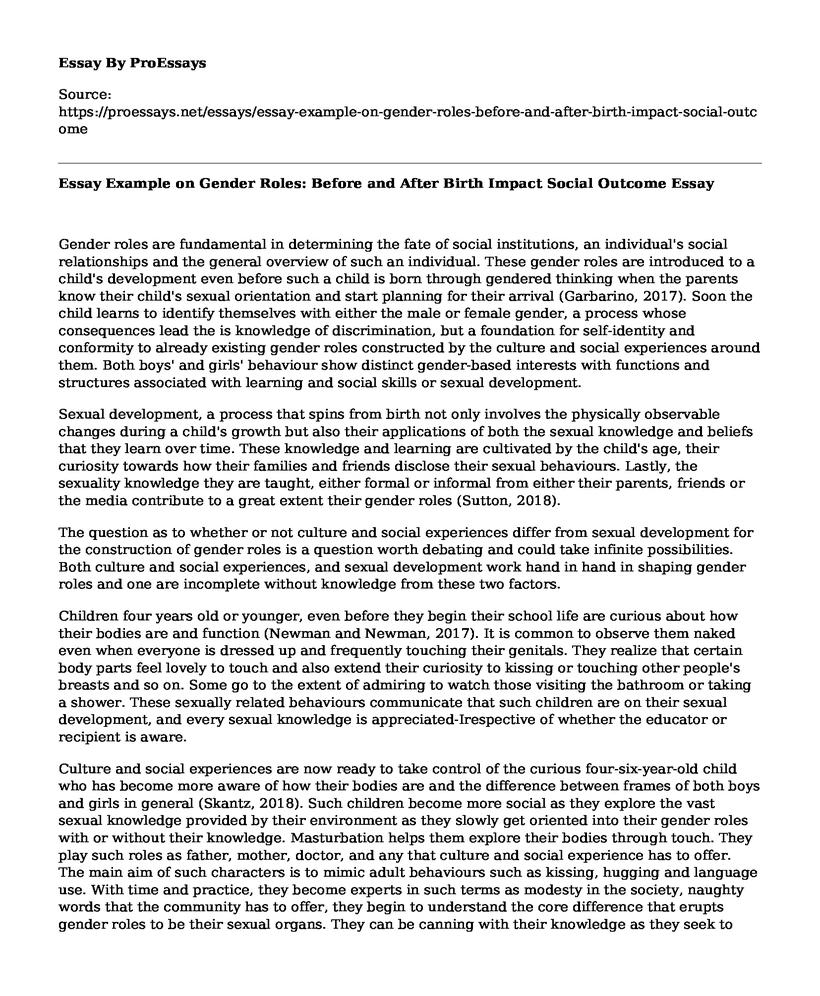Gender roles are fundamental in determining the fate of social institutions, an individual's social relationships and the general overview of such an individual. These gender roles are introduced to a child's development even before such a child is born through gendered thinking when the parents know their child's sexual orientation and start planning for their arrival (Garbarino, 2017). Soon the child learns to identify themselves with either the male or female gender, a process whose consequences lead the is knowledge of discrimination, but a foundation for self-identity and conformity to already existing gender roles constructed by the culture and social experiences around them. Both boys' and girls' behaviour show distinct gender-based interests with functions and structures associated with learning and social skills or sexual development.
Sexual development, a process that spins from birth not only involves the physically observable changes during a child's growth but also their applications of both the sexual knowledge and beliefs that they learn over time. These knowledge and learning are cultivated by the child's age, their curiosity towards how their families and friends disclose their sexual behaviours. Lastly, the sexuality knowledge they are taught, either formal or informal from either their parents, friends or the media contribute to a great extent their gender roles (Sutton, 2018).
The question as to whether or not culture and social experiences differ from sexual development for the construction of gender roles is a question worth debating and could take infinite possibilities. Both culture and social experiences, and sexual development work hand in hand in shaping gender roles and one are incomplete without knowledge from these two factors.
Children four years old or younger, even before they begin their school life are curious about how their bodies are and function (Newman and Newman, 2017). It is common to observe them naked even when everyone is dressed up and frequently touching their genitals. They realize that certain body parts feel lovely to touch and also extend their curiosity to kissing or touching other people's breasts and so on. Some go to the extent of admiring to watch those visiting the bathroom or taking a shower. These sexually related behaviours communicate that such children are on their sexual development, and every sexual knowledge is appreciated-Irespective of whether the educator or recipient is aware.
Culture and social experiences are now ready to take control of the curious four-six-year-old child who has become more aware of how their bodies are and the difference between frames of both boys and girls in general (Skantz, 2018). Such children become more social as they explore the vast sexual knowledge provided by their environment as they slowly get oriented into their gender roles with or without their knowledge. Masturbation helps them explore their bodies through touch. They play such roles as father, mother, doctor, and any that culture and social experience has to offer. The main aim of such characters is to mimic adult behaviours such as kissing, hugging and language use. With time and practice, they become experts in such terms as modesty in the society, naughty words that the community has to offer, they begin to understand the core difference that erupts gender roles to be their sexual organs. They can be canning with their knowledge as they seek to learn more, but some are honest and will frequently ask such questions as to why there is such a difference between the bodies of boys and girls.
Conclusion
In conclusion, it is the combination of both the cultural and social experiences as well as sexual development that ultimately guide the construction of gender roles. When the society provides the best care towards curious children, either from a social setup, media and more importantly, the family, children learn to appreciate their differences. They embrace each other's uniqueness and give rise to a generation that not only understands the existence of gender roles but also willing to overcome the division such functions may have.
References
Garbarino, J. (2017). Children and families in the social environment. Transaction Publishers.
Newman, B. M., & Newman, P. R. (2017). Development through life: A psychosocial approach. Cengage Learning.
Skantz Aberg, E. (2018). Children s collaborative technology-mediated storymaking: Instructional challenges in early childhood education.
Sutton, G. W. (2018). Discussion Guide for A House Divided: Sexuality, Morality, and Christian Cultures. Geoffrey W. Sutton.
Cite this page
Essay Example on Gender Roles: Before and After Birth Impact Social Outcome. (2023, Apr 23). Retrieved from https://proessays.net/essays/essay-example-on-gender-roles-before-and-after-birth-impact-social-outcome
If you are the original author of this essay and no longer wish to have it published on the ProEssays website, please click below to request its removal:
- Feminine Identity Essay Example
- The Situational Analysis and the Strategic Communications Plan Paper Example
- Working of Visualization Tools and Social Network Utilization
- Literary Analysis Essay on Romeo and Juliet: A Reflection of Today's Evil Society
- Middleboro Community Health Center: Comprehensive Mental Health Services & Programs - Essay Sample
- Essay Example on Four Parenting Styles: Benefits and Outcomes
- Free Paper on Adderall Abuse Among College Students: Causes, Effects, and Societal Concerns







